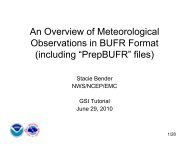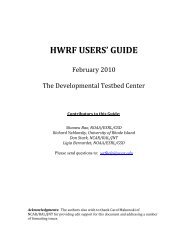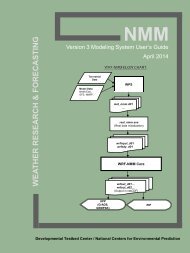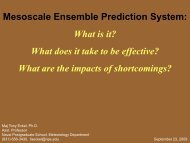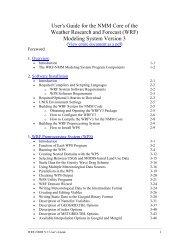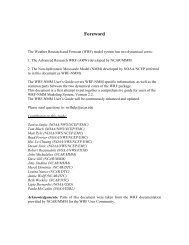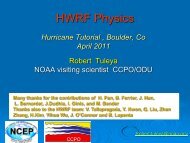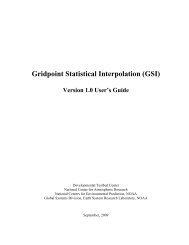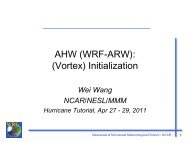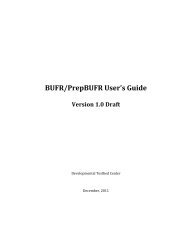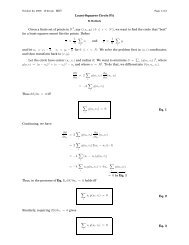Advanced Hurricane WRF (AHW) Overview
Advanced Hurricane WRF (AHW) Overview
Advanced Hurricane WRF (AHW) Overview
Create successful ePaper yourself
Turn your PDF publications into a flip-book with our unique Google optimized e-Paper software.
<strong>Advanced</strong> <strong>Hurricane</strong> <strong>WRF</strong><br />
(<strong>AHW</strong>)<br />
<strong>Overview</strong><br />
Jimy Dudhia
<strong>AHW</strong> Introduction<br />
• <strong>AHW</strong> is a sub-set of the community release of<br />
<strong>WRF</strong> defined by certain namelist choices<br />
• Uses the ARW dynamical core and physics<br />
• Introduced in 2005 Atlantic hurricane season<br />
– Paper by Davis et al. (2008, Mon. Wea. Rev.)<br />
Prediction of Landfalling <strong>Hurricane</strong>s with the <strong>Advanced</strong> <strong>Hurricane</strong> <strong>WRF</strong> Model,<br />
2008,: Mon. Wea. Rev., 136, 1990-2005.<br />
Mesoscale & Microscale Meteorological Division / NCAR
<strong>AHW</strong> Introduction<br />
Features<br />
• Option for automatic vortex-following multiplelevel<br />
moving nests<br />
• Special hurricane options since Version 3.0<br />
include<br />
– 1d ocean mixed-layer model<br />
– high-wind surface flux and drag formulations<br />
• Current domains are 36/12/4 km or 12/4/1.33<br />
km for Atlantic real-time system at NCAR<br />
Mesoscale & Microscale Meteorological Division / NCAR
<strong>AHW</strong> Introduction<br />
• Flexible configuration of grids, input<br />
datasets (e.g. ocean mixed layer<br />
information), data assimilation<br />
techniques<br />
• Version 3.3 includes a new idealized<br />
case for a tropical cyclone<br />
Mesoscale & Microscale Meteorological Division / NCAR
Modeling System Components<br />
• <strong>WRF</strong> Pre-processing System (WPS)<br />
– Real-data interpolation for NWP runs<br />
– New obsgrid program for adding more obs to analysis<br />
• <strong>WRF</strong> Model ARW dynamical core<br />
– Initialization programs for real and (for ARW) idealized data<br />
(real.exe/ideal.exe)<br />
– Numerical integration program (wrf.exe)<br />
• Graphics and verification tools including MET<br />
• <strong>WRF</strong>-Var - data assimilation<br />
• <strong>WRF</strong>-Chem - <strong>WRF</strong> coupled with atmospheric chemistry model
WPS Functions<br />
• Define simulation domain area (and nests)<br />
• Produce terrain, landuse, soil type etc. on the<br />
simulation domain (“static” fields)<br />
• De-grib GRIB files for meteorological data (u, v, T, q,<br />
surface pressure, soil data, snow data, sea-surface<br />
temperature, etc.), e.g. GFS, GFDL analyses.<br />
• Interpolate meteorological data to <strong>WRF</strong> model grid<br />
(horizontally)<br />
• Optionally add other gridded information, such as<br />
ocean mixed layer/heat content initial conditions<br />
• Optionally add more observations to analysis<br />
(separate obsgrid program)
WPS<br />
Function (cont)<br />
• Support <strong>WRF</strong> nesting<br />
• Map projections:<br />
– Lambert conformal, Polar stereographic,<br />
Mercator, rotated lat/long<br />
• C-grid staggering
<strong>WRF</strong>-DA (Data Assimilation)<br />
• Variational data assimilation (3D-Var and 4D-Var)<br />
• Ensemble DA (used currently for real-time <strong>AHW</strong><br />
system)<br />
• Hybrid variational/ensemble DA<br />
Function<br />
• Ingest observations to improve <strong>WRF</strong> input analysis<br />
from WPS<br />
• May be used in cycling mode for updating <strong>WRF</strong> initial<br />
conditions after <strong>WRF</strong> run<br />
• Also used for observation impact data studies
<strong>WRF</strong> real and ideal functions<br />
• REAL<br />
– Creates initial and boundary condition files for<br />
real-data cases<br />
– Does vertical interpolation to model levels (when<br />
using WPS)<br />
– Does vertical dynamic (hydrostatic) balance<br />
– Does soil vertical interpolations and land-use<br />
mask checks<br />
• IDEAL (ARW only)<br />
– Programs for setting up idealized case<br />
– Simple physics and usually single sounding<br />
– Initial conditions and dynamic balance
<strong>WRF</strong> Model<br />
• <strong>WRF</strong><br />
– Dynamical core (ARW) is compile-time selectable<br />
– Uses initial conditions from REAL or IDEAL<br />
– Real-data cases use boundary conditions from<br />
REAL<br />
– Runs the model simulation with run-time selected<br />
namelist switches (such as physics choices,<br />
timestep, length of simulation, etc.)<br />
– Outputs history and restart files
ARW Dynamics<br />
Key features:<br />
• Fully compressible, non-hydrostatic (with hydrostatic<br />
option)<br />
• Mass-based terrain following coordinate, eta<br />
t<br />
,<br />
s<br />
t<br />
where pi is hydrostatic pressure,<br />
mu is column mass<br />
• Arakawa C-grid staggering<br />
v<br />
u T u<br />
v
ARW Model<br />
Key features:<br />
• 3rd-order Runge-Kutta time integration<br />
scheme<br />
• High-order advection scheme<br />
• Scalar-conserving (positive definite option)<br />
• Complete Coriolis, curvature and mapping<br />
terms<br />
• Two-way and one-way nesting
ARW Model<br />
Key features:<br />
• Choices of lateral boundary conditions<br />
suitable for real-data and idealized<br />
simulations<br />
– Specified, Periodic, Open, Symmetric, Nested<br />
• Full physics options to represent atmospheric<br />
radiation, surface and boundary layer, and<br />
cloud and precipitation processes<br />
• Grid-nudging and obs-nudging (FDDA)<br />
• New Digital Filter Initialization option
Graphics and Verification Tools<br />
• NCAR Graphics Command Language (NCL)<br />
• RIP4 (Read, Interpolate and Plot)<br />
• ARWPost<br />
– Conversion program for GrADS and Vis5D<br />
• <strong>WRF</strong> Post-Processor (WPP)<br />
– Conversion to GriB (for GrADS and GEMPAK)
User Support<br />
• Email: wrfhelp@ucar.edu<br />
• User Web pages:<br />
http://www.mmm.ucar.edu/wrf/users/<br />
– Latest update for the modeling system<br />
– <strong>WRF</strong> software download<br />
– Various documentation<br />
• Users’ Guide<br />
• Technical Note (ARW Description)
ARW <strong>Hurricane</strong> Katrina Simulation<br />
(4km)



